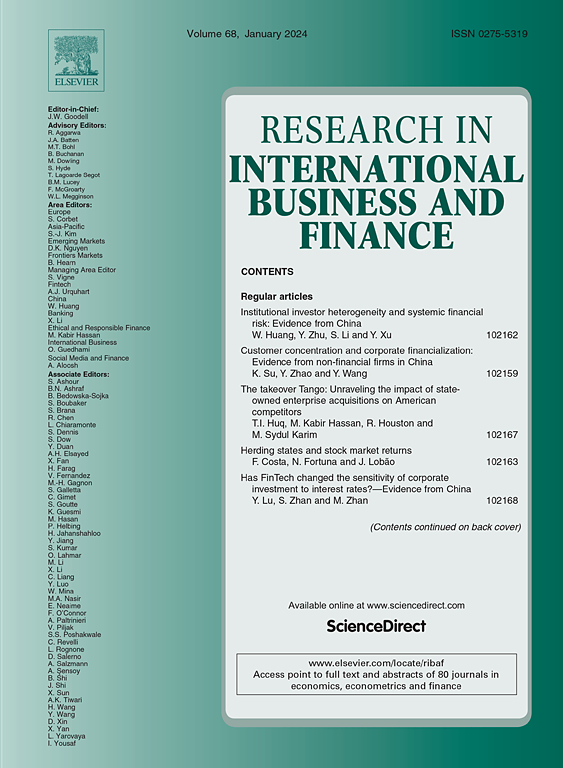Systemic risk among China’s financial sectors: Novel evidence from trivariate CoVaR based on vine copulas
IF 6.9
2区 经济学
Q1 BUSINESS, FINANCE
Research in International Business and Finance
Pub Date : 2025-05-23
DOI:10.1016/j.ribaf.2025.102968
引用次数: 0
Abstract
The purpose of this paper is to extend the measure of systemic risk by introducing a trivariate CoVaR that accounts for tail dependence and one-to-many risk spillovers. Unlike the traditional bivariate CoVaR, which captures only one-to-one systemic risk, the proposed measure distinguishes between trivariate upside and downside CoVaRs, integrating risk measurement, tail dependence, and spillover effects within a unified framework. First, we derive the analytical expressions for the trivariate CoVaR using vine copulas, demonstrating that it generalizes the bivariate CoVaR. We further show that ignoring tail dependence leads to overestimating systemic risk in traditional bivariate CoVaR. We construct a vine copula-based trivariate CoVaR model and perform numerical simulations, which confirm its effectiveness in capturing one-to-many risk spillovers while enhancing out-of-sample stability. Finally, we conduct an empirical analysis of systemic risk in China’s banking, securities, and insurance sectors, covering the period from January 2007 to December 2024. Our findings indicate that (1) the trivariate CoVaRs of the insurance sector to the banking and securities sectors exceed its own VaRs but remain lower than the bivariate CoVaRs, emphasizing the importance of cross-sector risk spillovers and (2) the trivariate CoVaRs of the insurance sector remain stable across financial cycles, reflecting the risk-sharing, and return-sharing characteristics of China’s financial system. These findings underscore the necessity for financial institutions and regulators to consider cross-sector dependencies when assessing systemic risk.
中国金融部门的系统性风险:来自基于vine copula的三变量CoVaR的新证据
本文的目的是通过引入考虑尾部依赖和一对多风险溢出的三变量CoVaR来扩展系统风险的度量。传统的双变量CoVaR只捕获一对一的系统风险,与之不同,该方法区分了三变量上行和下行CoVaR,在统一的框架内整合了风险度量、尾部依赖和溢出效应。首先,我们利用vine copula导出了三元CoVaR的解析表达式,证明了它推广了二元CoVaR。我们进一步表明,在传统的双变量CoVaR中,忽略尾部依赖性会导致高估系统风险。我们构建了一个基于vine copula的三变量CoVaR模型,并进行了数值模拟,验证了该模型在捕获一对多风险溢出的同时增强了样本外稳定性的有效性。最后,我们对2007年1月至2024年12月期间中国银行业、证券业和保险业的系统性风险进行了实证分析。研究结果表明:(1)保险业对银行业和证券业的三变量covar超过其自身的var,但仍低于双变量covar,强调了跨行业风险溢出的重要性;(2)保险业的三变量covar在金融周期中保持稳定,反映了中国金融体系的风险共担和收益共担特征。这些发现强调了金融机构和监管机构在评估系统性风险时考虑跨部门依赖关系的必要性。
本文章由计算机程序翻译,如有差异,请以英文原文为准。
求助全文
约1分钟内获得全文
求助全文
来源期刊

Research in International Business and Finance
BUSINESS, FINANCE-
CiteScore
11.20
自引率
9.20%
发文量
240
期刊介绍:
Research in International Business and Finance (RIBAF) seeks to consolidate its position as a premier scholarly vehicle of academic finance. The Journal publishes high quality, insightful, well-written papers that explore current and new issues in international finance. Papers that foster dialogue, innovation, and intellectual risk-taking in financial studies; as well as shed light on the interaction between finance and broader societal concerns are particularly appreciated. The Journal welcomes submissions that seek to expand the boundaries of academic finance and otherwise challenge the discipline. Papers studying finance using a variety of methodologies; as well as interdisciplinary studies will be considered for publication. Papers that examine topical issues using extensive international data sets are welcome. Single-country studies can also be considered for publication provided that they develop novel methodological and theoretical approaches or fall within the Journal''s priority themes. It is especially important that single-country studies communicate to the reader why the particular chosen country is especially relevant to the issue being investigated. [...] The scope of topics that are most interesting to RIBAF readers include the following: -Financial markets and institutions -Financial practices and sustainability -The impact of national culture on finance -The impact of formal and informal institutions on finance -Privatizations, public financing, and nonprofit issues in finance -Interdisciplinary financial studies -Finance and international development -International financial crises and regulation -Financialization studies -International financial integration and architecture -Behavioral aspects in finance -Consumer finance -Methodologies and conceptualization issues related to finance
 求助内容:
求助内容: 应助结果提醒方式:
应助结果提醒方式:


